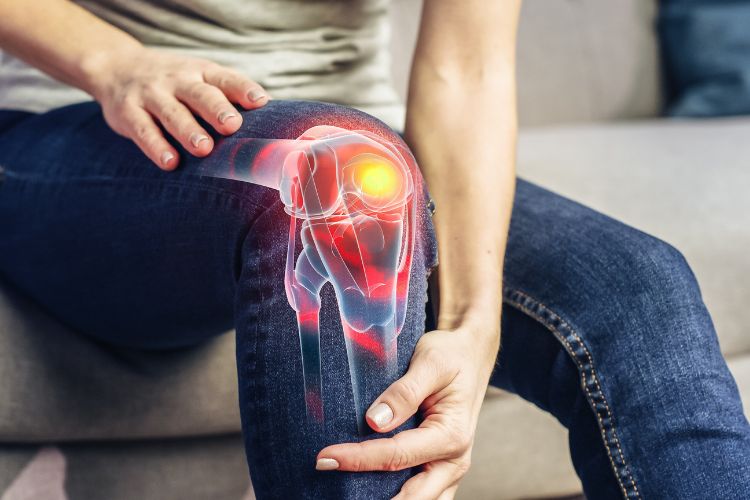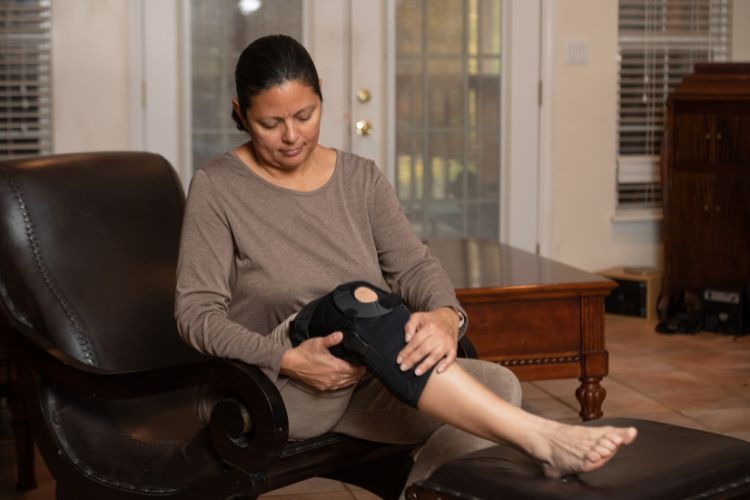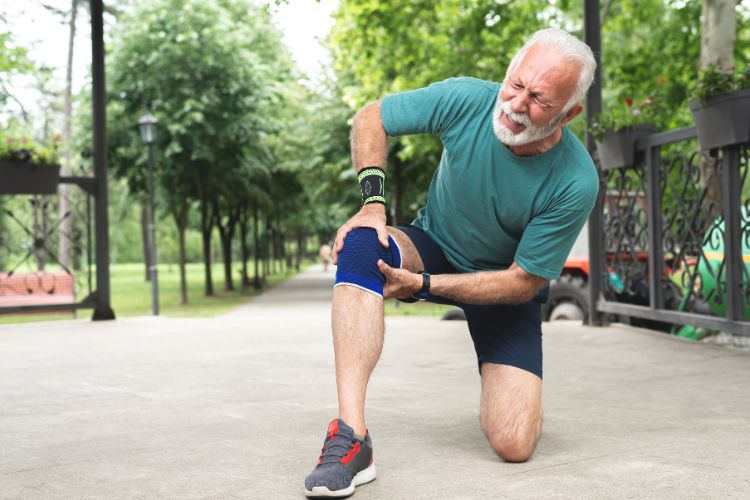When your knee feels tight when bending, it could be due to a number of causes. This can be a debilitating problem. But even when it is not, it can have a serious impact on the quality of your life. Knee tightness when bending can interfere with your daily activities, and a lot of the things that you normally enjoy doing.
Knee tightness can be caused by arthritis, an injury, or inflammation caused by a wide range of medical conditions. It must always be addressed before the problem becomes worse.
Use this guide to learn everything you need to prepare for the discomfort when your knee feels tight when bending.
Causes of Knee Tightness
There are many different causes of knee tightness. If your knee feels tight when bending, you may have an injury of the meniscus, which is damage to the cartilage between the bones of your knee. You may also have an existing fracture, or an old fracture that did not heal properly. A ligament injury or strain may be the cause of knee tightness, or you may have tendonitis.
Many knee problems that cause tightness when bending are also caused by arthritis which is wear and tear on the knee joint. You may also have bursitis, which is an inflammation of the fluid-filled sacs called bursa that cushion the knee joint. A gout knee occurs when there is crystal formation around the knee joint, and this can also cause incredible pain or tightness.
Muscle imbalances which cause the biomechanics of the knee to become unbalanced can also cause knee tightness. This occurs when the structure of one of your knees is damaged, but the other knee is fine. The knee system is an intricate system of sockets, joints, and cartilage structure along with the connective tissue that pulls it all together.
When one side of the body is suffering, the other side will feel unbalanced. This is a common cause of knee tightness as your body favors one side while the injured side becomes weaker. Any kind of knee pain can lead to tightness or stiffness when the knee is bent. You need to have the problem diagnosed in order to overcome this knee pain, which could only worsen in time and become a permanent problem.

Symptoms and Diagnosis
The knee is designed to do a wide range of things. It is meant to be an active part of your body as it is a critical connecting joint of the two longest parts of your body, your leg bones. The knee has components that glide and roll and spin in perfect concert in a healthy human body.
When any one component is suffering, there will be knee tightness when bending, or even when trying to straighten the knee. A diagnosis to get to the root of the issue could be very complex.
The knee is meant to bend and move to 145-degree angles, and you want to see from 40 to 50 degrees of rotation on the knees. Most of the things we do with our knees do not require this range, but that capacity is there. Going down stairs for example requires a perpendicular knee of 90 degrees.
Everything else that we do ranges in degrees of motion for the knee, unless the knee is feeling very tight.
The more you can move your knee in these ranges, the greater your chance of being able to recover from the tightness completely. Still, you may need multiple tests to determine the root cause of your issues. You should see a doctor as soon as the problem occurs, or if it worsens over time.
When you can’t bear weight on the knee, or have swelling that is unusual or getting worse, it is time to see a doctor. If the knee is looking deformed or the leg has a new deformity that is not going away with ice and standard pain medications, you should see a doctor. Any time your pain is severe enough to interfere with your life for more than a few days is another indicator to seek medical advice for your knee stiffness or tightness.
Your doctor will perform X-rays and ultrasounds, and take a medical history to determine the root cause of your knee issue. When the doctor views your images, you will be able to learn what is causing your knee tightness and develop a treatment plan to resolve the issue as quickly as possible.

Home Remedies and Exercises
There are many things that you can do at home to treat knee tightness when bending. A brace or protection around the knee can help considerably.
You also want to apply the RICE method when you can, and as soon as you can. This is Rest, Ice, Compression, and Elevation. Keep the knee elevated as often as you can until the tightness begins to dissipate for longer periods of time.
Ice on and off will help as well. Compression can be accomplished with tensor wraps or bandages that help to bring the swelling down and keep it down. Anti-inflammatory medication such as non-steroidal anti-inflammatories (NSAIDs) like ibuprofen can help as well.
There are exercises that you can do to help your knee as well. Stretching will help, but only do so if the range of motion allows. Additionally, light lunges in place will help to stretch the muscles, but do not do this if you are feeling sharp pains in the knee. Only perform stretches when you feel you are working the muscle, and not hurting it. Ease into your stretches and exercise poses slowly to prevent additional injury.
You also want to be sure that you are doing the same exercises on both sides of the body to maintain balance. Light exercises that are low impact such as biking, elliptical work, or swimming can help knee tightness considerably. Stay active when you can to keep the muscle memory working in your favor.
Medical Treatments For Knee Pain When Bending
There are many medical treatments for knee pain when bending. You may only need some medication and ice to heal the knee and get back to your daily activities. Some cases are prescribed physical therapy in order to keep the range of motion monitored with light activity.
Injections such as corticosteroids and hyaluronic acid can help as well. These are injections of fluid that are similar to the fluid in the knee that lubricates and cushions the knee. Corticosteroids will reduce the inflammation and the flare-ups that cause heat and tightness, but may not always be effective.
There are some cases such as with a torn meniscus that require surgery. Your doctor may need to repair joint damage as well, or even replace the knee. Here, the doctor will only replace the damaged components of your knee with artificial knee parts that will help you get your range of motion back. Extreme cases of knee damage involve removing bone segments from other parts of the body to relieve knee pain.
In many cases, some lighter surgeries are performed in order to prevent a total knee replacement. Still, knee surgery is a major life change, and you may not get complete knee motion back. You will get close though, and you will be in better shape and have better mobility than you did before you needed the surgery.
Prevention
Preventing knee problems is the fastest way to prevent existing knee problems from becoming worse, or from starting new problems in the knee. Lifestyle factors play a large role in knee pain prevention. If you have any excess weight, your doctor will want you to work at taking as much off as you can to get to a healthy weight. Having too much weight will create a burden on the joints and make existing knee pain worse.
Additionally, excess weight will put you at a greater risk of osteoarthritis. Having too much weight on the bones will break down the cartilage between the bones and could result in permanent knee problems. In addition to working on losing weight, you want to be sure that you eat a healthy diet and maintain an active lifestyle.
Healthy bone function and range of motion rely on having strong muscles. If you can, perform weight-bearing activities on the legs in order to strengthen the bones and muscles of the knee. You can do this with light weights at a gym or fitness center or do exercises at home that can help you strengthen your legs. Biking is an excellent way to build strength and muscle in your knee joints and legs.
You can also prevent knee problems by staying away from activities that will put a strain on your legs. Skiing for example puts a great amount of stress on the legs, and you will see a lot of injuries to the knees in this sport.
If you stand a lot at work or have a job that requires repetitive stress to the knees you may also be at risk of a recurring knee problem. You also want to avoid any of these activities if you already have a knee injury. If you feel knee stiffness when the knee is bent, take measures to adjust your activity level until that issue is resolved.
When you are trying to prevent knee problems, be reasonable about it. Use common sense and avoid things that will bother your knees. You may need to adjust your lifestyle and make changes to your daily routine to prevent permanent knee damage.
Take Control of Knee Pain When Bending
When your knee feels tight when bending, it can feel like you will never be the same person again. You will be. You just need to make some changes to your daily routines until you feel better. There are many medical causes of knee tightness when bending, and they are all treatable. You may need to see a doctor if the problem does not go away.
Knee tightness can go away if you catch it early, and you seek medical attention when you need to. You can live your life and take control of the problem before it becomes something you think about every day.
